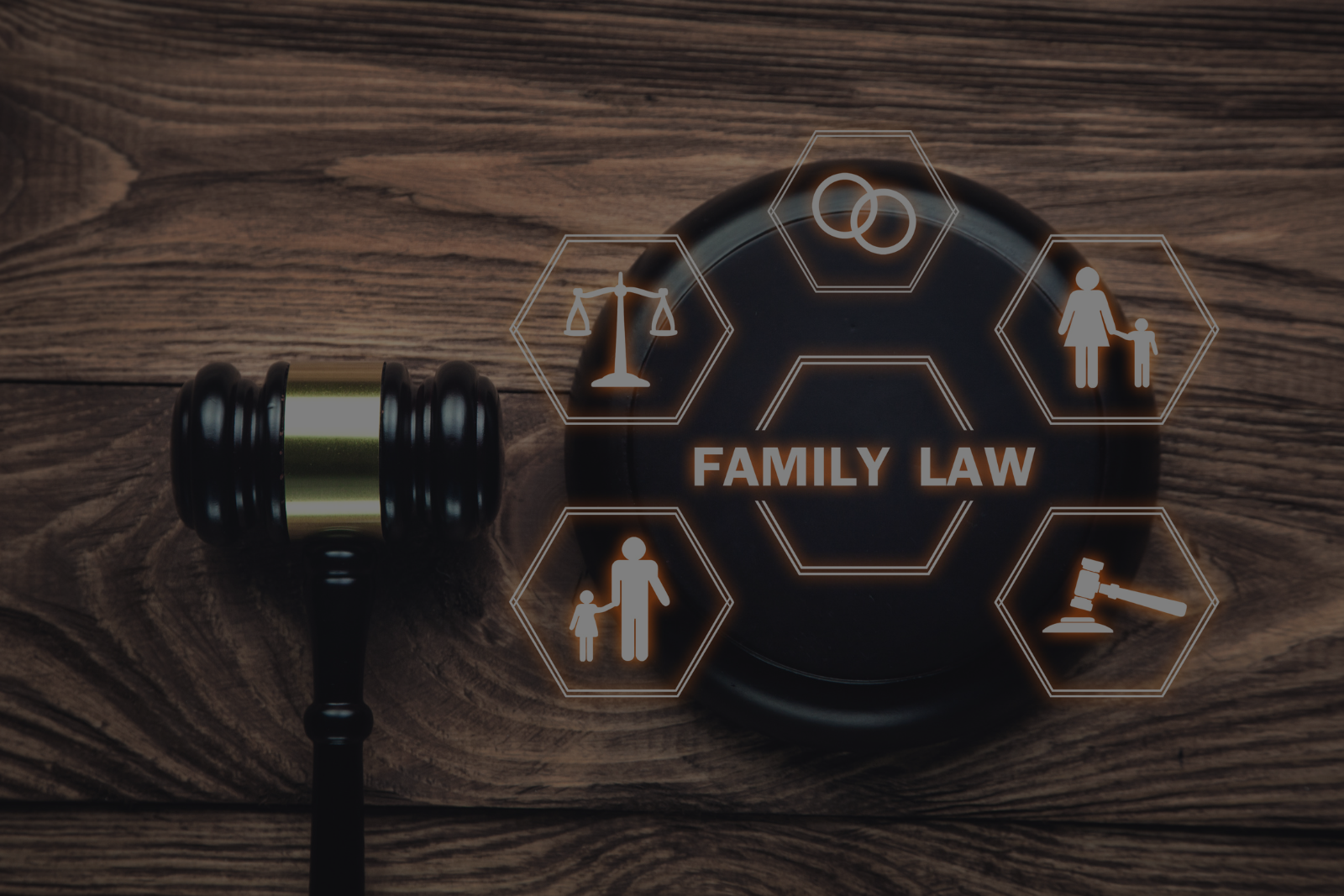Child Support Lawyers

Child Support
Child support can be confusing for all involved, whether you’re a parent who doesn’t see your children much but pays child support, a parent with full time care of children or a non-parent carer.
Child support can be complex, and it is ok if you don’t understand why or how child support maintenance is calculated or why it may change over time.
We are here to help and guide you through your family law matters. For help with child support or any other family law matter, contact the family lawyers at Ivy Law Group on 02 9262 4003.
What is child support in Australia?
Child support is governed by Services Australia (formerly known as the Department of Human Services, but commonly referred to as the Department or the Child Support Agency).
The child support scheme ensures that children of a marriage or de facto relationship (unless in Western Australia) are financially supported by their parents when parents are going through a separation or divorce.
Child support is for the financial benefit of the children of the marriage or de facto relationship, not for the benefit of either of the parents.
Each parent (whether a father, mother or non-parent carer) has a duty to maintain their child in the form of child support payments. This is set out in the Child Support (Assessment) Act 1989.
Services Australia is responsible for administering the child support legislation, not the Family Court of Australia or the Federal Circuit Court of Australia. The Court only has the power to make orders in certain circumstances, such as a Departure Order, a Child Maintenance Order or an Adult Child Maintenance Order (since Services Australia does not deal with these issues).
Agreements about child support can be made when deciding other family law matters, such as parenting matters, property settlement matters, or spousal maintenance matters.
Who is required to pay child support?
Any parent, whether biological or adoptive, is liable to pay child support.
If there is an issue about the paternity of the child, then a DNA test may be required to prove that the other party is the biological parent of the child you are seeking child support maintenance for.
Who can receive child support?
Any parent, guardian or carer, who cares for the child at least 35% of the time over a 12-month period can receive child support.
The amount you receive may be calculated by Services Australia or can be governed by a private Child Support Agreement as agreed between the parents or non-parent carer.
How are child support payments made?
Child support payments can be made directly or indirectly to the receiving parent or guardian by way of:
- Periodic payments
Here, child support is paid directly to the receiving parent or guardian on a regular basis. These payments can be changed to reflect the costs of living or any change in care arrangements. Payments can be either assessed by Services Australia or set out in either a Limited Child Support Agreement or a Binding Child Support Agreement.
- Non-Periodic payments
Child support payments are made indirectly to third parties to go towards, for example, school fees, uniforms, or sporting and extra-curricular activities. An agreement for non-periodic payments must be specific in either a Limited Child Support Agreement or a Binding Child Support Agreement.
- Lump Sum payments
Child support paid by a lump sum payment can be credited against the total amount payable under the assessment for child support. The value of the lump sum payment must be equal to, or exceed, the amount that the receiving parent is entitled to receive as assessed by Services Australia. That is unless you enter into either a Limited Child Support Agreement or a Binding Child Support Agreement (in which case if there is an agreement you may receive a lump sum payment plus additional periodic payments – but this must be agreed by the parents).
- Non-agency payments
Child support considered as a non-agency payment can be paid directly or indirectly to the receiving parent or guardian or to a third party (such as paying a debt owed by the other parent or paying for services or goods). Non-agency payments are not enforceable but can be credited up to 30% of any administrative assessment by Services Australia without agreement (or up to 100% if agreed by both parents).
What child support options do I have?
Initially, there are two ways to determine child support:
- have it calculated by the Child Support Assessment by Services Australia
- enter into a Child Support Agreement, either limited or binding, that is negotiated and agreed by both parents
Alternatively, in certain circumstances, you may be able to make an application to the Court to have one of the following orders made in relation to child support:
- Departure Order
- Court Ordered Child Maintenance
- Court Orders for Adult Child Maintenance.
How to apply for child support in Australia
Services Australia can make an assessment for child support payments. This is the most common form of child support arrangement, as the assessment is made directly by Services Australia. Child support is then collected and distributed by Services Australia.
Services Australia automatically reviews the child support assessment every 18 months, and reassesses if necessary, to ensure that the assessment is up to date. The review is based on the last income tax return filed by each parent with the ATO. However, you can also provide updated information to Services Australia if any circumstances change which may affect child support payments.
What are care arrangements?
Care arrangements are based on each parent’s care of a child which forms part of the child support assessment.
It is important to know that care arrangements are different from child support. Child support is the financial contribution to raising a child and is assessed by Services Australia (using the formula detailed below). Care arrangements, on the other hand, are decided under the Family Law Act 1975 and are based on who the child spends time with or in the care of (based on what is in the child’s best interests).
Care arrangements are usually worked out in percentage terms, based on the number of nights the child spends in each parent’s care. Care arrangements can be calculated by the time spent under final Court Orders or consent Orders, or under a Parenting Plan or any other document that records the time each parent spends with the child.
For example, if the child lives with one parent for nine nights per fortnight and spends time with the other parent for five nights per fortnight, then this will be considered the care arrangements and a percentage will be calculated of that care. If there are separate arrangements for sharing school holidays, those nights will also need to be taken into consideration to work out the average time a child spends with each parent in each year.
What are the best interests of the child?
There are two primary considerations in determining what is in the best interests of the child:
- the benefit of the child having a meaningful relationship with both parents,
- the need to protect the child from any harm, or risk of harm, such as family or domestic violence or child abuse.
If there is an allegation of risk of harm to the child, the Family Law Act 1975 states that the Court must protect the child and this consideration will override the child’s benefit in having a meaningful relationship with both parents.
In these circumstances, the Court may make an Order for supervised contact time on an interim basis until further evidence about the alleged risk of harm has been considered and determined by the Court on a final basis (that is, until final Parenting Orders are made). Supervised time can happen at a supervised contact centre or with an agreed supervisor (who may be known to both parents).
How are care arrangements calculated into percentage terms?
Services Australia has five levels of care when they work out the cost percentage terms for child support. These are:
- Below regular care
Time spent with the child between 0% to 13% of care, which is equivalent to less than two nights per fortnight (or less than 51 nights per year)
- Regular care
Time spent with the child between 14% to 34% of care, which is equivalent to two to four nights per fortnight (or 52 to 127 nights per year)
- Shared care
Time spent with the child between 35% to 65% of care, which is equivalent to five to nine nights per fortnight (or 128 to 237 nights per year)
- Primary care
Time spent with the child between 65% to 86% of care, which is equivalent to 10 to 12 nights per fortnight (or 238 to 313 nights per year)
- More than primary care
Time spent with the child more than 86% of care, which is equivalent to more than nine nights per fortnight (or more than 238 nights per year).
A parent who provides primary care, or more than primary care, does not have to pay child support since the other parent is not considered an “eligible carer” of the child.
A paying parent will pay less child support maintenance based on the amount (percentage) of care they provide for each child. For example, a paying parent who has spent time with the child on a shared care basis, will pay less than a paying parent who only has regular care of their child.
What if our care arrangements change?
If Services Australia has assessed your care arrangements and they change at any point, you will need to inform Services Australia within 28 days of the changes. This is because changes in care arrangements may mean the paying parent’s child support payments are increased or decreased accordingly.
If the paying parent’s care increases and they inform Services Australia within 28 days from the date of the change, then in most cases Services Australia will backdate the payments to when the change occurred.
However, if you don’t update Services Australia about changes to your care arrangements, then the paying parent may pay too much or wind up with a debt if you did not pay enough. Alternatively, the receiving parent may wind up having to pay back an overpayment of child support.
How does Services Australia calculate child support?
If you cannot come to an agreement about child support maintenance with your former spouse or de factor partner, or do not enter into a private agreement about child support maintenance, child support payments can be assessed by Services Australia to determine how much child support either parent will pay or receive.
It is important to know that Services Australia is responsible for administering the child support legislation, not the Family Court of Australia or the Federal Circuit Court of Australia.
Child support payments are calculated using a formula that takes into account both parents’ taxable incomes, the ages of the children and the level of each parent’s care for the children. For example, in circumstances where a child is an infant and is being breastfed, they will live primarily with one parent and spend time with the other. The parent who has less care of the child will pay the other parent child support.
Services Australia uses the following formula to calculate child support payments:
- Assessing both parent’s income
- Calculating the combined taxable income of both parents:
Parent A’s income + Parent B’s income = Combined Parent’s Income
- Calculating each parent’s taxable income ‘percentage’ from the combined income of both parents, and then dividing each parent’s by their combined total:
Parent A’s income / Combined Parent’s Income = Parent A’s Income Percentage
or
Parent B’s income / Combined Parent’s Income = Parent B’s Income Percentage
- Assessing each parent’s percentage for the care of the children
- Calculating the cost percentage for the care of the children
- Determining the child support percentage by subtracting the cost percentage from the income percentage for both parents:
Cost Percentage of Parent A – Combined Parent’s Income = Child Support Percentage of Parent A or
Cost Percentage of Parent B – Combined Parent’s Income = Child Support Percentage of Parent B
- Assessing the costs of the child based on the combined total income of the parents
- Calculating the total amount of child support payable, then multiplying the costs of the child by the postive child support percentage.
This formula will allow you to determine how much child support you will pay or receive. You can calculate your estimated child support maintenance payments on Services Australia’s website.
You or the other parent may request that the current child support payments be reassessed if the care arrangements change for whatever reason. For example, if the child is withheld from the other parent and they are unable to see the child, that parent can contact Services Australia for a reassessment of both parents’ child support obligations.
When will child support payments end?
In most cases, child support payments are made until the child turns 18 years of age. However, child support payments will end earlier if the child:
- becomes self-sufficient and is able to financially support themselves adequately
- marries another person or enters into a de facto relationship with another person
- dies
- is adopted to another person who then assumes financial support for the child.
Child Support Agreements
If you and the other parent can agree on what amount of child support will be paid to which parent and how it is going to be paid, the second option is to put the agreement into either a Binding or Limited Child Support Agreement. This agreement must be signed by both parents.
Ideally, these agreements should include a degree of flexibility so that if the care percentage changes significantly there is room to move. If the person receiving child support has less than 35% care, however, the agreement terminates automatically (unless the terms of the agreement provides for a period of suspension of the agreement during that period of change of care).
You can register a Child Support Agreement with Services Australia and lodge it with the Court. Services Australia may collect and distribute the child support payments as directed by the agreement.
Limited Child Support Agreement
A Limited Child Support Agreement (LCSA) is the more flexible of the two child support agreements.
To enter into a LCSA:
- Services Australia calculates the child support payments that are to be paid with the amount of child support payable being not be less than (but can be more than) the assessed amount calculated by Services Australia
- you do not need legal advice
- you must agree on whether the agreement can be terminated after three years from the date of the agreement or can be continued.
Binding Child Support Agreement
A Binding Child Support Agreement (BCSA) is less flexible but it allows you to come to an agreement with your former spouse or de facto partner without any involvement from Services Australia.
To enter into a BCSA:
- the agreement must be between two parents and identify the child or children
- the agreement must specify what child support payments are to be made, whether periodic, non-periodic, lump sum or non-agency payments (the amount payable does not have to be assessed by Services Australia, and it can be less or more than what would be required by Services Australia)
- the agreement must be in writing, dated and be signed by both parties
- both parties must have received independent legal advice (and show this by a statement confirming that both parties have received independent legal advice or a certificate, signed by a solicitor, confirming both parties have individually received legal advice).
A BCSA can only be changed or terminated through either an agreement which terminates the BCSA or an Application to the Family Court of Australia.
We highly recommend that you obtain legal advice if you wish to make this application with the Court as it is a complex area of law.
If you’re ready to get professional family law advice, contact our family law firm, Ivy Law Group, on 02 9262 4003 to arrange a free, no-obligation initial consultation.
Registering a Binding Child Support Agreement with Services Australia
You can register a BCSA with Services Australia within 28 days of executing the BCSA by following these steps:
- draft a letter to Services Australia, requesting that they register the BCSA
- enclose a completed Application for Acceptance of Child Support Agreement form from Services Australia (noting that your lawyer will have to complete Section 1 of the application, you’ll need to sign page 11, a certified copy of the BCSA will need to be attached and you or your lawyer will need to send the original Application to Services Australia)
- Services Australia will send a letter directly to both parties (which may take up to eight weeks)
- on receipt of the letter from Services Australia, either you or your lawyer will need to register the BCSA with the Family Court of Australia so that the Court can enforce provisions for non-periodic payments, as Services Australia can only enforce and collect periodic payments on your behalf.
Lodging the Agreement with the Court
Usually there are terms in the BCSA that the parties are to lodge a certified copy of the registered BCSA to the Court.
You will need to execute an affidavit attaching the following:
- a copy of the BCSA
- copies of the correspondence with Services Australia, confirming their acceptance of the terms of the BCSA.
Filing the Affidavit with the Court will allow you to enforce non-periodic child support payments in the future if the other party refuses or fails to meet the child support payments.
Departure Orders
What is a Departure Order?
A Departure Order is when a parent with a child support assessment from Services Australia applies to the Court to depart from that administrative assessment. This area of law is governed by the Child Support (Assessment) Act 1989.
Application to the Court for a Departure Order
The administrative review process
Part 6 of the Child Support (Assessment) Act 1989 sets out the administrative process for a parent to depart from the administrative process that has been determined by Services of Australia. The process is as follows:
- either parent, individually or together, completes an application form to initiate the process
- Services Australia will review the application to determine if there are any reasons for a departure from the existing child support payments
- a copy of the application must be sent to the other parent, if it was not a joint application and the other parent must respond within 14 days with the response sent to Services Australia and the parent who initiated the application
- a hearing will be organised to determine the issues at hand and the Registrar will make a decision as to whether there are reasons for the existing child support payments to be changed or departed from.
This process takes approximately 90 days from the date of the application to the Registrar’s written decision. The timeframe may vary depending the nature of the application and whether it is a joint or sole application.
When can a parent apply to the Court for a change of assessment?
Usually, a parent (or non-parent carer) must apply to the Child Support Registrar before they can make an application to change the current administrative child support assessment.
A parent can only apply directly to the Court if:
- they are the paying parent of child support and the assessed rate is the minimum of child support payable under the relevant legislation, or
- the paying parent has another matter in Court at the same time (for example parenting or property settlement proceedings) and the Court is satisfied that it would be in the interests of the paying parent for the Court to consider if a departure Order should be made.
In what circumstances can a Court make a Departure Order?
The Court can make a departure order if it is satisfied that one of the reasons for departure exists and it would be fair to make the Order (s 117 Child Support (Assessment) Act 1989).
The reasons for departure include where:
- the capacity of a parent to provide financial support for the child has significantly reduced because of:
- their duty to maintain another child or person (including if the child or person has special needs)
- necessary commitments of the parent to help that parent either support themselves or another child or person that they have a duty to maintain
- higher costs involved for that parent to spend time with, or communicate with, another child or person that they have to maintain
- the costs of maintaining the child are significantly affected because of:
- higher costs involved in the parent spending time, or communicating, with the child
- high childcare costs in relation to the child
- the child being cared for, educated or trained in the manner that is expected by the parents
- an application in relation to the child under the legislation relating to Services Australia’s administrative assessment would result in an unfair level of financial support that the paying parent has to pay because of:
- the income, earning capacity, property and financial resources of the child or either parent
- any payments, or transfer or settlement of property, which are to be made to the paying parent for the benefit of the child
- the paying parent’s responsibility to maintain a resident child significantly reduces their capacity to support the child.
If a parent, or both parents, apply to Services Australia to change the current assessment of child support payments, and Services Australia objects to making any change, then an application for a Departure Order can be made to the Court.
Payments of Child Support until an Application for a Departure Order has been decided
While the Court hears and considers an application for a Departure Order, the paying parent must continue to pay the child support maintenance as assessed by Services Australia. If the paying parent stops making these payments, then Services Australia can collect the payments in certain circumstances.
However, a paying parent may also make an application to the Court for a Stay Order until the outcome of the application for departure order. This means that the paying parent does not have to make any further payments until the decision is made.
Entering into a Child Support Agreement to depart from the administrative assessment
The alternative to making an application to the Court for a departure order is to enter into a Child Support Agreement to change the assessed amount of child support payable. Both parents must agree to the terms of the Child Support Agreement when entering into it.
The written agreement must follow the specific requirements set out in the relevant legislation. If Services Australia accepts the agreement, they will start collecting the child support payments in accordance with the agreement.
You and the other parent can enter into a Child Support Agreement to change an earlier Child Support Agreement or before a Court makes a Departure Order.
Adult child maintenance
There is no doubt that when it comes to raising a child, it comes with a price tag – and that doesn’t stop when they turn 18 years old. As an adult, they have just finished high school or an apprenticeship and have little financial independence, despite being able to vote and consume alcohol.
Your child’s financial independence may not come straight away as they may enter into tertiary study or continue completing their apprenticeship, which means they still live with their parents. This means they are still receiving financial support, eating, using the “free” internet or electricity and taking the family car whenever its needed.
For families who have separated or divorced, child maintenance payments are made until a child reaches the age of 18 years old and becomes an adult. But what happens when a child has special needs or is still in secondary school or continuing their studies? When these situations arise, the Family Court of Australia and the Federal Circuit Court of Australia have the power to make orders for the maintenance of an adult child.
What is adult child maintenance?
Adult child maintenance is the financial support paid by the paying parent (who doesn’t reside with the child) to the receiving parent (who resides with the child) to assist with necessary everyday living expenses of their adult child.
The adult child may need financial assistance because they are studying (whether it be secondary or tertiary education, TAFE or an apprenticeship), have a physical or mental disability, a serious illness or in any other circumstances that the Court considers it’s fair to make an Order.
Calculating adult child maintenance
A Court considers the following when calculating adult child maintenance:
- the adult child’s necessary expenses, whether that’s food, housing, utilities, household supplies, expenses for their studies (such as textbooks, internet or technology), medical or care expenses
- the financial position of each parent and their ability to provide that support
- the financial support that both parents need to support themselves and any other dependent children or other person they have a responsibility to maintain.
Adult child maintenance payments can be provided indefinitely, or more commonly may continue for a specified time, such as until the adult child finishes university.
How to enforce child support maintenance payments
If the paying parent does not pay the periodic child support maintenance as assessed, or as agreed in the registered agreement, the Child Support Registrar may use its power to obtain the child support payments by:
- compelling the employer of the paying party to make payments directly to Services of Australia from the paying party’s income to meet their obligations, with the remainder of the income to be paid to the paying party, or
- recovering the payments from either social security benefits, such as Centrelink or Family Tax Benefits, or the paying party’s tax refund.
If the Registrar is unable to obtain the unpaid child support payments, then either the Registrar or the receiving party of the outstanding payments is entitled to make an application to the Court to recover the outstanding debt.
If the agreement has been registered with the Family Court, you can also make an application to the Court for enforcement of non-periodic payments, such as payment of school fees or school uniforms or medical expenses, as set out in the agreement. The Child Support Registrar is unable to collect and enforce non-periodic payments under a child support agreement.
We recommend that you obtain legal advice if you wish to enforce a child support maintenance payment or recover a debt.
For family law advice tailored to your circumstances, contact the family lawyers at Ivy Law Group on 02 9262 4003.
Family tax benefit payments
What is family tax benefit? And how are these payments affected by child support payments?
Family tax benefits (FTB) are payments that help families, who are eligible, with the cost of raising their children. FTB is made up of:
- FTB Part A: a payment paid per child with the amount payable dependent on the family’s financial circumstances
- FTB Part B: a payment paid per family, providing additional financial support to single parents and some families who only have one taxable income support the family.
You can receive FTB payments fortnightly or as a lump sum payment at the end of each financial year.
Will my Family Tax Benefit be affected by Child Support Payments?
Your FTB Part A payments may be affected if you receive child support payments as it is the responsibility of a parent to financially support their child.
Services Australia will use a maintenance income test to work out how much your FTB Part A payment will be reduced. It is important to know that you can receive a certain amount of child support maintenance without it affecting your FTB Part A payments.
Once the threshold (known as Maintenance Income Free Area) has been met, then your FTB Part A payments will be reduced by 50 cents in every dollar of child support that you receive. The Maintenance Income Free Area depends on:
- whether you receive more than the base rate of FTB Part A payments
- whether you or your partner receive, or are entitled to receive, child support maintenance (or spousal maintenance).
It is important to know that the amount of child support maintenance will not reduce, only the FTB Part A payment will be reduced.
However, if you enter into a Child Support Agreement which provides for less periodic child support than you would receive under the administrative assessment, your FTB Part A payment will be reduced.
How can Ivy Law Group help you?
Our family lawyers have extensive experience dealing with child support and other family law matters. Contact the family lawyers at Ivy Law Group on 02 9262 4003 to arrange a free, no-obligation initial consultation.
FAQs about child support maintenance
The legal term for “child maintenance” is child support. Child support payments are the responsibility of the parents to ensure that the needs of their children are financially met. The support meets the necessary everyday expenses of the children.
Adult child support payments are the responsibility of the parents to ensure that the needs of a child (who is over the age of 18 years) are financially met. The support meets the necessary everyday expenses of the child.
The “paying parent” is the parent that pays child support maintenance payments to the other parent as the child is living with them. This is the same for adult child maintenance payments.
The “receiving parent” is the parent that the child lives with and they receive the child support payments from the other parent to meet their child’s necessary living expenses.
If your ex is the paying parent and stops paying child support payments, the Child Support Registrar may use its power to obtain the child support payments through certain mechanisms, such as obtaining the payments from the paying parent’s employer directly. For more information, please read “How to enforce child support payments”.
You apply for child support payments through Services Australia (Child Support Agency) where they will make an administrative assessment based on certain criteria (such as the financial position of both parents, care arrangements and many other factors). Alternatively, you can enter into a Child Support Agreement if you and the other parent can come to an agreement about how much maintenance is to be paid.
You do not make an application with the Court for child support maintenance, unless you are seeking maintenance for an adult child who is over the age of 18 years or you’re seeking a Departure Order.
Child support maintenance is determined and assessed by Services Australia. There is a handy calculator tool on their website which will estimate child support payments you will need to pay/receive from the other parent. You can get any child maintenance forms from Services Australia for an administrative assessment to be done.
Usually when the child turns 18 years old, or if the child becomes financially self-sufficient, marries someone or enters into a de facto relationship, dies, or is adopted.
The person who pays child support is the parent that the child does not live with but spends time with. For example, if the child lives with one parent for ten nights in a fortnight and spends time with the other parent for four nights per fortnight, then the parent that spends less time with the child will be the one liable to pay child support payments.
You can make a Family Tax Benefit claim by logging onto your mygov.com.au account.
If you need further information, please contact Services Australia (Child Support Agency) directly.





